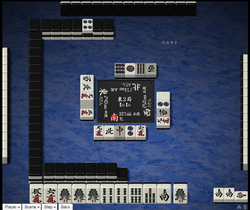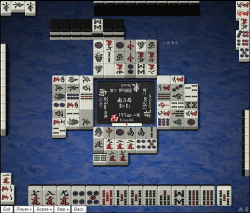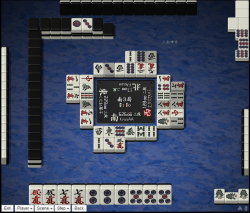Kan

Kan 「カン」 is a special tile call in the game. This call forms a tile grouping of four identical tiles, called kantsu 「槓子」. Just like all tile calls, the call itself is optional; thus, an opportunity to call kan is not mandatory.
While appearing as a four-of-a-kind, the tiles used to form kantsu actually function as a three-of-a-kind plus one extra tile. With that in mind, tiles called for kan still interpreted as "triplets" particularly for triplet-based yaku, such as toitoi and sanankou. For every kan declaration, players are required to take an extra tile draw from the dead wall. This drawn tile is called the rinshanpai, or dead wall draw. After the kan call and player's discard, then another dora indicator is revealed.
The call for kan is a discretionary play, with its own set of rules and restrictions. Under all circumstances, a player may call kan or decline when given the opportunity. The strength of kan play stems from the exclusive access to the dead wall and the revealing of additional dora. At the same time, kan play is very risky, where other players may end up as the benefactors. Therefore, players may decline calling the kan to minimize risk. Choosing to do so or not, this play does require some assessment; and players are not encouraged to make such calls recklessly. On the other hand, players may rely on kans, when it is needed.
Procedure

Like the other tile calls, kan is also a tile call. However, it comes with special properties and rules. These rules apply when a player possesses or gains possession of four of the same tile; and then the player makes the kan call.
- The player calls "kan".
- The four identical tiles are shown and are set aside, like an open call. Together, the four tiles now count as one tile group.
- Then, a replacement tile is drawn from the dead wall. This acts as the replacement tile to maintain the proper hand size for four groups and a pair.
- If this tile draw completes the hand. then the player may declare a win and claim rinshan kaihou.
- Otherwise, the last tile from the wall is added to the dead wall, so that the dead wall contains 14 tiles at all times.
- If the hand has an additional opportunity to call kan, then the player may do so and invokes another kan process.
- Otherwise, the turn may end by discarding normally.
A special case may involve the yaku, chankan. If the kan call involves a shouminkan and the added tile is a winning tile for another player, then chankan may be applied upon the declaration of another player's winning hand. In this case, the hand ends before the player even gets to draw the extra tile from the dead wall. Thus, the process of calling kan gets interrupted in favor of another player's winning hand.
Kandora timing
The call for kan reveals additional dora in the form of kandora. The timing of this reveal is variable, depending on the rule set and/or game platform. The simplest rule invokes an immediate reveal upon the declaration; and so, this rule would immediately place the kan reveal after step 1. Others distinguish the timing between open and closed kans. Here, closed kans would be granted an immediate reveal; however, open kans would produce another kandora indicator after the discard, upon conclusion of the kan process at step 8. Regarding the timing of the kandora, players will need to consult organizational, tournament, and/or local rules.
Kan types
Kan can occur under three different occasions; and thus, there are three types of kan based on drawing order:
- Closed triplet with the fourth tile type discarded
- Open triplet with the fourth tile type drawn
- All four tile types drawn
Daiminkan
Daiminkan 「大明槓」 is also called an "open kan". A player possesses three of a tile type within the hand. Then the fourth is discarded. The player may claim the discarded tile and form a daiminkan. Upon doing so, the player has opened the hand, if the hand was initially closed.
Most rules do not allow to flip the kan dora indicator immediately after a daiminkan declaration. It is usually flipped after discarding, or upon another kan declaration on the same turn. Some rules allow the kan dora indicator to be flipped immediately.
A daiminkan may not be made with the last discard of the game, which invokes the follow up procedure to take a rinshanpai. Because all tiles from the regular wall are used, no replacement tile from the regular wall to the dead wall could be made in order to maintain the dead wall at 14 tiles. Taking a rinshanpai in this case would reduce the dead wall count to 13, which not acceptable.
Some rules invoke sekinin barai on a player discarding into the daiminkan.
Shouminkan
Shouminkan 「小明槓」 is referred as an "added kan", where a player had previously called pon to form a minkou, or open triplet. Upon drawing the fourth tile, the player may add that tile to the minkou and upgrade it to a shominkan. If the fourth tile was discarded by another player, it cannot be claimed by kan. The kan dora indicator is flipped at the same time as for a daiminkan. Another term to describe this kan is kakan 「加槓」.
The player may declare this kan during any turn; and therefore, the player does not need to declare kan immediately at first opportunity. If the player has just claimed a discarded tile instead of drawing a tile from the wall or the dead wall, then the ability to declare kan is disabled on this turn. The player would have to wait for the next tile draw instead. It is also forbidden to declare a kan while the wall is empty, because the dead wall cannot be replenished.
This kan call is vulnerable to one specific yaku: chankan or robbing the kan. If another player is tenpai and the added tile completes his hand, that player may call ron immediately after the shominkan declaration. It ends the hand before the kan is completed; therefore no new kan dora indicator is flipped.
Ankan
Also known as a "closed kan", a player may draw all four of a tile type. Unlike the other two kan types, ankan 「暗槓」 keeps the hand closed, unless the hand has been opened previously. Thus, even with an ankan call, the player may still have the option of declaring riichi even with such a kan call, calling kan during riichi barring restrictions, and/or winning the hand via mentsumo.
Per rule variation, the kandora indicator is flipped immediately with an ankan call, rather than waiting for the player's discard or the rinshan draw.
Like a shominkan, an ankan may be declared during the player's turn. As such, the player holds all four tiles. The same restrictions as for the shominkan apply. An ankan may not be subject to chankan, except against a kokushi tenpai, if the rules allow.
Tile arrangements
Tiles called for "kan" are set aside. In most cases, they are called for open tile groups. However, one arrangement in particular still indicates a closed hand ("menzen").
Closed
The first arrangement is preferred, but the second arrangement is also acceptable.
Called
Daiminkan are indicated as open tile groups, with the four tiles next to each other and one tile turned to indicate the player it was called from. For daiminkan claims from toimen, or the player across, it does not matter which "middle" tile is turned sideways, as long as it is one of the middle tiles.
Added
Shouminkan are indicated as open tile groups, by stacking the added tile above the rotated tile from the original minkou.
Multiple kan calls
If in possession with the proper tiles, a player may call kan more than once consecutively. The extremely rare case of up to four consecutive kan calls within a single turn is possible.
In this example, kan may be called twice in a row after drawing 1-man. Both the 1-man and south may each be called for shominkan, before making a discard. Naturally, this must be done one at a time, following the proper procedure for kan.
As for kan dora, ankan (closed kan) is the only case, where a new indicator is shown immediately after the kan call. Otherwise, the number of kan indicators is one less than the number of kan consecutive calls. In the case of the above example, two added kans were called sequentially; but only one kan dora indicator was shown upon winning the hand.
Restrictions
Some restrictions apply to kan calls. The restrictions are based on tile counts and rules pertaining to riichi itself.
Kan during riichi
A player may be allowed to call a closed kan during riichi, depending on the hand's composition.
Under most professional rulesets, a player is not allowed to call kan if it would change the hand's possible winning tiles, or if it would change any possible interpretation of the hand. If, for any winning tile, any of the three identical tiles can be interpreted as part of a sequence or part of the pair, the kan is not allowed.
Under some rulesets, such as in tenhou.net and Mahjong Soul, an alternative is used: so long as a kan does not change the hand's possible winning tiles, the kan is allowed. (I.e., even if a kan would change a possible interpretation of the hand, it is allowed.)
If a player does declare a kan illegally during riichi, and they call ron or the game goes to an exhaustive draw, then they will be penalized with a chombo penalty for breaking the rule. If a player is not required to reveal their hand, or if another player wins, they will normally not be penalized.
Of course, even if a kan is allowed, players may choose to decline a kan call. While a player can benefit from kan dora (and kan uradora), so will their opponents.
Example 1:
It is not allowed to kan the fours. The manzu tiles may either be interpreted as a 3-4 ryanmen wait and a 4-4 pair, or as a 4-man ankou with a 3-man tanki wait. Overall, the hand waits for 2-5-3 man. A kan call would change the wait to just the 3-man tanki, and is thus forbidden. It is allowed to kan the west winds, since they would be considered an ankou no matter which tile is won.
Example 2:
In this example, none of the waits are affected by any of the kan possibilities. The waiting tiles are completely unrelated to any of the existing triplets in this hand. Therefore, it is acceptable to call kan during riichi here.
Example 3:
Here, the waits are 457p. A kan on 6p would remove the 7p wait, so it is obviously not permitted.
A kan on the 3p would not change the waits. However, if the hand was won with 4p, the hand could be interpreted as:
In this case, the 3p does not form a triplet, but rather a pair and a part of a sequence. A kan on the 3p would remove this potential interpretation of the hand, and therefore may be forbidden (depending on ruleset).
Example 4:
In this example, a kan declaration does not change the wait, but it does change the possible interpretations of the hand. The pinzu section can be interpreted either as three consecutive triplets or three identical sequences :
In this case, a kan call on any of the pinzus would leave only the three triplets interpretation possible. Thus, any of these kan would be deemed illegal after riichi (depending on ruleset).
Last tile

Kan cannot be called after drawing the last tile, as the live wall is empty and so a tile cannot be moved to the dead wall. Part of the kan process requires live tiles from the end of the wall to be transferred to the dead wall. If this is not possible, then kan is not possible.
Tile calls
After taking a discarded tile, a player cannot call kan, even if a player has the tile(s) available in hand to do so. The next opportunity to call kan comes after the next tile draw. This does not apply when a daiminkan is called, as the kan causes a tile to be drawn immediately.
Suukaikan
This is an "abortive draw" regarding kan calls. From the dead wall, only four tiles can be used for the extra draw, or rinshanpai. The remaining tiles from the dead wall are used as dora indicators, or they are tile replacements from the regular wall. Neither of these two tile type can be used in play. As a result, the limit of kan calls for a hand session is set to four. After the fourth kan call, the kyoku (hand session) ends after the rinshan draw and subsequent discard.
However, an exception is made for players with suukantsu tenpai. After the fourth kan call, the game continues, giving the player a chance to score the yakuman. Under many rulesets, the other players are not allowed to call a fifth kan to invoke the abortive draw. Some rule variations may allow a fifth kan to immediately end the game in a draw, though.[1] If this rule variation is used, the fifth-kan draw happens before chankan and rinshan can happen.
Yaku
In general, tiles called for kan are still applied as triplets. Any call for kan does not interfere with any yaku dependent on triplets, such as sanankou or yakuhai. Four yaku are centered around kan calls. One applies a win via the kan draw; and the other is applied to added kans. Then the last two are composed of kans.
Chankan
Chankan is a yaku applied on a shominkan (added kan) declaration. A hand in tenpai for a kan call on a tile added to a called pon may declare ron on that tile.
Rinshan kaihou
Rinshan kaihou is a yaku gained by calling tsumo on the replacement tile after any type of kan declaration.
Sankantsu and suukantsu
Both sankantsu and suukantsu require kan calls in order to count. The first requires three calls, while the latter calls for four. Both are rather difficult due to this requirement. Sankantsu is not a yakuman, but some yakuman are actually easier to attain. Suukantsu is by far the most difficult and most rare yakuman to attain.
Kan risks

The nature of kan dora makes the call for kan a risky maneuver. With this in mind, some quick assessment is needed before making such a call.
References
External links
- Kan in Japanese Wikipedia
| |||||||||||